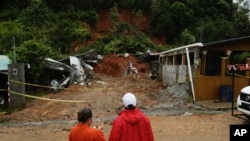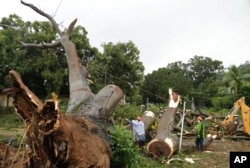Hurricane Otto strengthened to a Category 2 hurricane as it churned toward the sparsely populated Caribbean coast border of Nicaragua and Costa Rica Thursday as an unusually strong late-season storm.
Heavy rains from the storm were blamed for three deaths in Panama. Otto was forecast to make landfall Thursday in Nicaragua, just north of the Costa Rican border.
In Bluefields, Nicaragua — the nearest town of any size on the coast — residents prepared to ride out the hurricane.
"In our house, we have packed up some things in plastic bags and we went out to buy some provisions, just in case," said Bluefields resident Jean Hodgson. "But if we had to leave our house, we don't know where we could take refuge." The area is low-lying and easily flooded.
Nicaragua closed schools and was evacuating more than 10,000 people from communities in the storm's path. Heavy rains were expected to affect the entire country, raising the possibility of flooding and landslides.
Officials in Costa Rica ordered the evacuation of 4,000 people from its Caribbean coast and called off school nationwide for the rest of the week. Heavy rain was already causing flooding in some areas and the president announced that public employees would not have to work Thursday or Friday.
No hurricane has made a direct landfall in Costa Rica since reliable record-keeping began in 1851.
The U.S. National Hurricane Center said the storm regained hurricane strength late Wednesday night after fluctuating between tropical storm and hurricane status earlier this week. By Thursday morning, Otto's maximum sustained winds had increased to near 105 mph (165 kph) with additional strengthening possible before landfall.
The storm caused heavy rains in Panama as it moved roughly parallel to that nation's northern coast, killing three people there.
Costa Rican President Luis Guillermo Solis said Otto could damage the country's important coffee and agriculture sectors.
Nicaragua also feared damage for impoverished farmers and to coffee crops that are almost ready for harvest.
Otto "could seriously jeopardize food security for small-holder farmers who rely on maize, beans, cocoa, honey, coffee and livestock for their livelihoods," said Jennifer Zapata, a regional director for Heifer International, a U.S.-based anti-poverty group.
Thursday morning, Otto was moving west near 8 mph (13 kph) and was centered about 70 miles (110 kilometers) north of Limon, Costa Rica, the hurricane center said.






